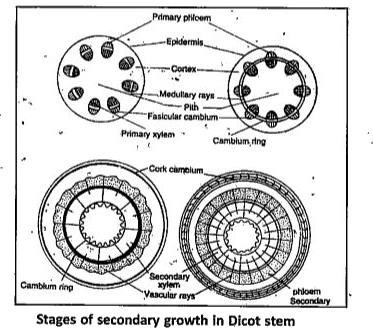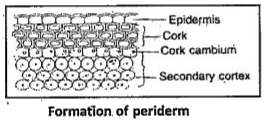Explain the process of secondary growth in stems of woody angiosperm with help of schematic diagrams. What is the significance? Solution in Telugu
Growth of stem or root in thickness due to the formation of secondary tissues due to the activity of primary and secondary meristems is called secondary growth.
Changes during secondary growth of a dicot stem are divided into two groups. They are
I. Intrastelar secondary growth. II. Extrastelar secindary growth.
I. Intrastelar secondary growth: The changes tha. occur inside the stele are called Intrastelar secondary growth. They are
A) Formation of vascular cambial ring :
1. Indicot stem, vascular bundles are in a circule ring. They are open type with fascicular cambiam.
2. Parenchyma in medullary rays dedifferentiate into secondary meristem connecting fascicular cambiam. These are called interfascicular cambiam.
3. Fascicular and interfascicular cambia fuse to form vascular cambial ring.
B) Activity of vascular cambium :
4. Vascular cambium has 2 types of initials.
a), Fusiform initials : They give rise to secondary xylem towards centre and secondary phloem to outside.
b) Ray initials : They produce phloem rays towards outside and xylem rays towards inside.
5. More secondary xylem is formed than secondary phloem.
6. Secondary xylem is called wood and secondary, phloem bast.

7. As stem increases in thickness primary phloem and primary xylem are crushed and removed.
8. Secondary xylem has vessels, fibres and xylem perenchyma. Vessels are pitted.
9. Secondary phloem has sieve tubes, companion cells, fibres and phloem parenchyma.
10. Xylem ray and phloem ray are also called vascular rays. They are helpful in lateral conduction and storage.
II. Extrastelar secondary growth : The changes which occur outside the stele are called Extrastelar secondary growth.
1. Due to the formation of more secondary vascular tissues a pressure is exerted on the epidermis causing its rupture. So a secondary protective layer (periderm) is formed.
2. Parenchyma cells in middle or inner cortex. dedifferentiate. into .a ring of secondary meristem. This is called cork cambium or phellogen. It cuts off new cells on both sides.

3. Tissue produced on outside is called cork tissue or : phellem. Tissue produced inside is called secondary - cortex or phelloderm.
4. The phellogen phellem and phelloderm together constitute periderm.
5. To facilitate gaseous exchange in the cork tissue certain bulged lens shaped structures are formed. They are called lenticels.
Topper's Solved these Questions
- MODEL PAPER 13BOOK - VGS PUBLICATION-BRILLIANTCHAPTER - MODEL PAPER 13EXERCISE - SECTION-A
5 Videos
- MODEL PAPER 13BOOK - VGS PUBLICATION-BRILLIANTCHAPTER - MODEL PAPER 13EXERCISE - SECTION-B
3 Videos
- MODEL PAPER 13BOOK - VGS PUBLICATION-BRILLIANTCHAPTER - MODEL PAPER 13EXERCISE - SECTION - B
8 Videos
- MODEL PAPER 12BOOK - VGS PUBLICATION-BRILLIANTCHAPTER - MODEL PAPER 12EXERCISE - SECTION-B
2 Videos
- MODEL PAPER 14BOOK - VGS PUBLICATION-BRILLIANTCHAPTER - MODEL PAPER 14EXERCISE - SECTION - C
11 Videos
Similar Questions
Distinguish between exocrine and endocrine glands with examples.
View SolutionWrite a short note on in-situ conservation.
View SolutionExplain binomial nomenclature.
View SolutionDefine Species. Explain the various aspects of 'Species'.
View SolutionIn which phase of meiosis are the following formed ? Choose the answers from hint points given below.
a) Synaptonemal complex…………
b) Recombination nodules…………..
c) Appearance /activation of a Enzyme recombinase……………
d) Termination of chiasmata
e) Interkinesis
f) Formation of dyad of cells.
View SolutionExplain the process of secondary growth in stems of woody angiosperm with help of schematic diagrams. What is the significance?
View Solutionचित्रों की सहायता से काष्ठीय एन्जियोस्पर्म के तने में द्वितीयक वृद्धि के प्रक्रम का वर्णन कीजिए इसकी क्या सार्थकता है ?
View Solutionचित्रों की सहायता से काष्ठीय एंजोस्पर्म के तने में द्वितीयक वृद्धि के प्रक्रम का वर्णन करो। इसकी क्या सार्थकता (significance) है?
View SolutionExplain the process of secondary growth in stems of woody angiosperm with help of schematic diagrams. What is the significance?
View Solutionचित्रों की सहायता से काष्ठीय एंजियोस्पर्म के तने में द्वितीयक वृद्धि के प्रक्रम का वर्णन कीजिए। इसकी क्या सार्थकता है ?
View Solutionনির্দিষ্ট চিত্র সহযোগে কাষ্ঠল গুপ্তবীজী উদ্ভিদের কাণ্ডে গৌণ বৃদ্ধির পদ্ধতি ব্যাখ্যা করো। এর তাৎপর্য কী?
View Solutionद्विबीजपत्री तने में द्वितीयक वृद्धि होने के कारण किसकी मोटाई बढ़ती है
View SolutionExplain the process of secondary growth in stems of woody angiosperm with help of schematic diagrams. What is the significance?
View SolutionExplain the process of secondary growth in stems of woody angiosperm with help of schematic diagrams. What is the significance?
View SolutionExplain the process of secondary growth in stems of woody angiosperm with help of schematic diagrams. What is the significance?
View SolutionExplain the process of secondary growth in stems of woody angiosperm with help of schematic diagrams. What is the significance?
View Solution
